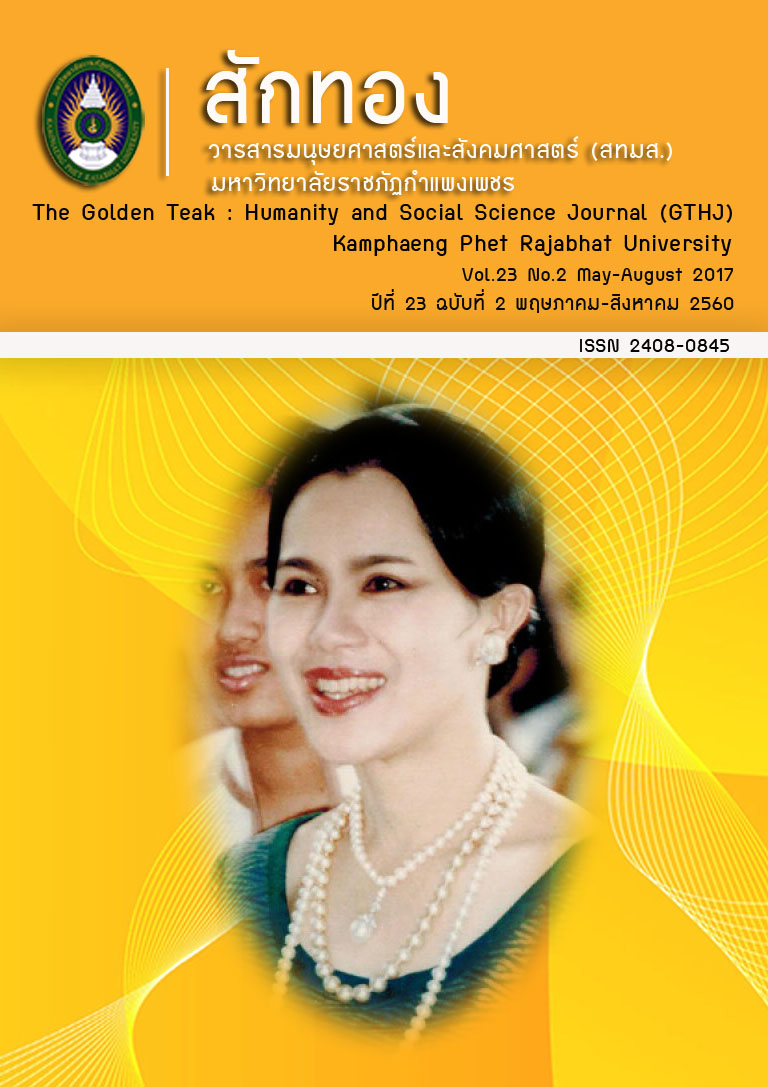การพัฒนารูปแบบการจัดการเรียนรู้คอมพิวเตอร์ โดยใช้ทฤษฎีคอนสตรัคชันนิสซึม เพื่อเสริมสร้างความคิดสร้างสรรค์ สำหรับนักเรียนชั้นประถมศึกษาปีที่ 4
Main Article Content
Abstract
บทคัดย่อ
การวิจัยครั้งนี้ มีวัตถุประสงค์เพื่อ 1. เพื่อสร้างและศึกษาคุณภาพของรูปแบบการจัดการเรียนรู้คอมพิวเตอร์ โดยใช้ทฤษฎีคอนสตรัคชันนิสซึม เพื่อเสริมสร้างความคิดสร้างสรรค์ สำหรับนักเรียนชั้นประถมศึกษาปีที่ 4 2. เพื่อศึกษาผลการทดลองใช้รูปแบบการจัดการเรียนรู้คอมพิวเตอร์ โดยใช้ทฤษฎีคอนสตรัคชันนิสซึม เพื่อเสริมสร้างความคิดสร้างสรรค์ สำหรับนักเรียนชั้นประถมศึกษาปีที่ 4 วิธีดำเนินการวิจัย ใช้ระเบียบวิธีวิจัยและพัฒนา มี 2 ขั้นตอน คือ 1 ขั้นสร้างและหาคุณภาพรูปแบบที่พัฒนาขึ้น ขั้นที่ 2 ขั้นดำเนินการใช้และศึกษาผลการใช้รูปแบบที่พัฒนาขึ้น กลุ่มตัวอย่าง ได้แก่ นักเรียนชั้นประถมศึกษาปีที่ 4 โรงเรียนอนุบาลสรรคบุรี จำนวน 34 คน ภาคเรียนที่ 1 ปีการศึกษา 2559 เรียนโดยใช้รูปแบบการเรียนการสอนที่พัฒนาขึ้น ใช้เวลาในการทดลอง 18 ชั่วโมง ทำการวิเคราะห์ข้อมูลด้วย ค่าสถิติ one-sample t-test ค่าร้อยละ ค่าเฉลี่ย และส่วนเบี่ยงเบนมาตรฐาน ผลการวิจัยพบว่า 1) ผลการสร้างและศึกษาคุณภาพของรูปแบบการจัดการเรียนรู้คอมพิวเตอร์ โดยใช้ทฤษฎีคอนสตรัคชันนิสซึม เพื่อเสริมสร้างความคิดสร้างสรรค์ สำหรับนักเรียนชั้นประถมศึกษาปีที่ 4 พบว่า (1.1) รูปแบบการจัดการเรียนรู้คอมพิวเตอร์ โดยใช้ทฤษฎีคอนสตรัคชันนิสซึม เพื่อเสริมสร้างความคิดสร้างสรรค์ สำหรับนักเรียนชั้นประถมศึกษาปีที่ 4 มีองค์ประกอบ 5 องค์ประกอบ ได้แก่ หลักการ วัตถุประสงค์ เนื้อหา กระบวนการจัดการเรียนรู้ การวัดและประเมินผล มีกิจกรรมการเรียนรู้ 4 ขั้น คือ (1) ขั้นมองปัญหาอย่างสร้างสรรค์ (2) ขั้นวางแผนจัดการปัญหา (3) ขั้นสร้างสรรค์ชิ้นงาน (4) นำเสนอควบคู่การประเมิน ผลการตรวจสอบคุณภาพโดยผู้ทรงคุณวุฒิ พบว่า รูปแบบการเรียนการสอนที่พัฒนาขึ้นมีความเหมาะสม อยู่ในระดับมาก (1.2) ดัชนีประสิทธิผลของรูปแบบการเรียนรู้ที่พัฒนาขึ้น มีค่าเท่ากับ 0.6917 2) ผลการใช้รูปแบบการจัดการเรียนรู้คอมพิวเตอร์ โดยใช้ทฤษฎีคอนสตรัคชันนิสซึม เพื่อเสริมสร้างความคิดสร้างสรรค์ สำหรับนักเรียนชั้นประถมศึกษาปีที่ 4 พบว่า (2.1) ความคิดสร้างสรรค์บนการทำชิ้นงานที่เกิดจากการเรียนรู้ระหว่างเรียนโดยใช้รูปแบบการจัดการเรียนรู้คอมพิวเตอร์ โดยใช้ทฤษฎีคอนสตรัคชันนิสซึม เพื่อเสริมสร้างความคิดสร้างสรรค์ สำหรับนักเรียนชั้นประถมศึกษาปีที่ 4 ของผู้เรียนเพิ่มขึ้นตามลำดับ และความคิดสร้างสรรค์ ของนักเรียนที่เรียนด้วยรูปแบบการจัดการเรียนรู้คอมพิวเตอร์ โดยใช้ทฤษฎีคอนสตรัคชันนิสซึม เพื่อเสริมสร้างความคิดสร้างสรรค์สำหรับนักเรียนชั้นประถมศึกษาปีที่ 4 โดยรวมหลังเรียนอยู่ในระดับดี (2.2) นักเรียนที่เรียนด้วยรูปแบบการจัดการเรียนรู้คอมพิวเตอร์ โดยใช้ทฤษฎีคอนสตรัคชันนิสซึม เพื่อเสริมสร้างความคิดสร้างสรรค์สำหรับนักเรียนชั้นประถมศึกษาปีที่ 4 มีความคิดสร้างสรรค์หลังเรียนสูงกว่าเกณฑ์ร้อยละ 70 อย่างมีนัยสำคัญทางสถิติที่ระดับ .05
A Development of Computer Instructional Model Based on Constructionism Theory to Enhance Creative Thinking for Grade IV Students
ABSTRACT
The purposes of this research were 1. To construct and studied quality of A Computer Instructional Model Based on Constructionism Theory to Enhance Creative Thinking for grade IV students. 2. To study the result of A Computer Instructional Model Based on Constructionism Theory to Enhance Creative Thinking for grade IV students. Research methodology, research and development has two phases. 1) Create and format for quality improvement. 2) The implementation of the study and the results of the model was developed. The sample consisted of 34 grade IV students from Anubansanburi School, Chainat Primary Educational Service Area Office, in 1st Semester Academic Year 2016. It took 20 hours to analyze the experimental data with the one-sample t-test statistics, percentages, averages and standard deviations. The results of the study were as follows : (1) The results and the quality of the instructional model : (1.1) A Computer Instructional Model Based on Constructionism Theory to Enhance Creative Thinking for grade IV students. A model consisted of 5 component: principles, objectives, contents, teaching and learning process, assessment and evaluation. The model was verified by the expert and it was found that a instructional model developed at the appropriate level. The result of the experiment showed that the teaching and learning through the activities follow the 5 stage : Creative problem view, Management problem plan, Creative task, Presentation and Evaluation. (1.2) Effectiveness Index of A Computer Instructional Model Based on Constructionism Theory to Enhance Creative Thinking for grade IV students is equal to 0.6917 (2) The experimental results using the instructional model found : (2.1) Creativity on the task of the learning between classes using A Computer Instructional Model Based on Constructionism Theory to Enhance Creative Thinking for grade IV students learners increased accordingly and the creativity of students by using A Computer Instructional Model Based on Constructionism Theory to Enhance Creative Thinking for grade IV students Overall Pretest after studying at a good level. (2.2) The student’s creative thinking ability after the intervention was significantly higher than the 70 at 05.
Article Details
บทความที่ได้รับการตีพิมพ์เป็นลิขสิทธิ์ของวารสาร สักทอง : วารสารมนุษยศาสตร์และสังคมศาสตร์ สถาบันวิจัยและพัฒนา มหาวิทยาลับราชภัฏกำแพงเพชร
ข้อคิดเห็นใดๆ ที่ปรากฎในวารสารเป็นวรรณกรรมของผู้เขียนโดยเฉพาะ ซึ่งมหาวิทยาลัยราชภัฏกำแพงเพชรและบรรณาธิการไม่จำเป็นต้องเห็นด้วย


